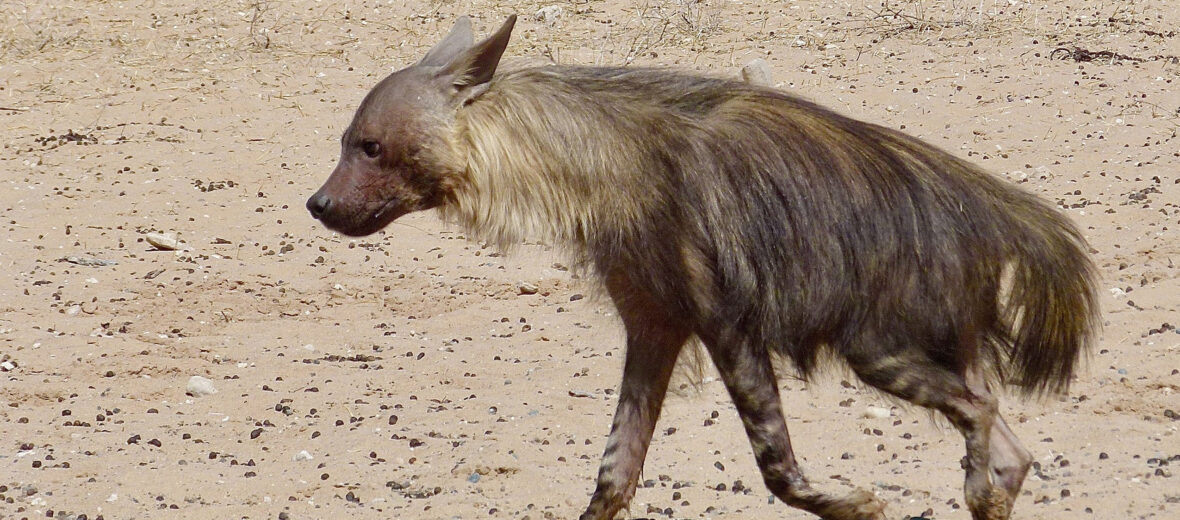
The brown hyena, aka brown hyaena or strandwolf, can be found in South Africa. They prefer semi-desert habitats, desert habitats, open scrubs, and open woodland savannas. Due to habitat loss at the hands of road and railroad developments (which result in habitat division and vehicle strike – being hit by vehicles), hunting, and trapping, these hyenas are listed as Near Threatened by the IUCN. However, as of 2014 their populations were considered stable.
First the Stats…
Scientific name: Hyaena brunnea
Weight: Up to 96 lbs.
Length: Up to 55 inches, plus up to a 14 inch tail
Height: Up to 31 inches, at the shoulders
Lifespan: Up to 13 years
Now on to the Facts!
1.) As of 2014, there were an estimated 10,111 brown hyenas remaining in the wild.
2.) The largest extent population of brown hyenas is located in the southern Kalahari Desert as well as the coastal areas in Southwestern Africa.
3.) Like other hyenas, these critters are nocturnal (active at night).
4.) They typically hunt individually and not in clans.
5.) A group of hyenas is called a cackle or clan.
But wait, there’s more on the brown hyena!
6.) Clans usually number up to 15 individuals.
7.) The clan typically includes related individuals and an alpha male from an outside source.
Did you know…?
Due to their incredible sense of smell, these critters can locate food from several miles away.
8.) The females are only nomadic when they lack cubs.
9.) These critters only defecate in latrine sites (where they go to the bathroom), located throughout their territory.
10.) Territories are denoted via scent marking and defecation.
But wait, there’s still more on the brown hyena!
11.) Besides their primary diet of carrion (dead animals) they will also prey on a variety of mice, rats, birds, insects, and fish. They will also take eggs, fruits, and vegetables.
12.) Their mating system varies based on the situation. They can be either polygynous (1 male mates with all the females in the clan), or polygynandrous (females and males mate with multiple partners), with females breeding with up to 4 males.
Did you know…?
These creatures have been documented traveling up to 21.75 miles in a single night in search of food.
13.) Mating occurs from May – August.
14.) The females will breed every 12 – 41 months.
15.) Females undergo up to a 90 day gestation (pregnancy) that yields up to 4 cubs.
But wait, there’s still a little more on the brown hyena!
16.) At 3 months the cubs begin eating solid food and are moved to a communal den.
17.) When cubs reach 15 months of age, they are fully weaned.
Did you know…?
A Duke University study demonstrated that a pair of hyenas were actually better at problem-solving and social cooperation than chimps. During that study, the hyenas were totally silent while working on all of the problems, using only non-verbal signals for communication between each other.
18.) Due to false conceptions, myths, and a general bad reputation, they are often killed by ranchers who believe they are eating their livestock. Livestocks are rarely touched, sans a rare instance of a single individual looking for an easy meal.
19.) Seeing as they are scavengers, they play a very important role in cleaning the landscape of dead and decaying carcasses. This helps prevent disease and aids in limiting fly populations.
20.) Their characteristic “laugh,” based on its tone and volume, can indicate things like age and social status.
But wait, there’s still just a tad more on the brown hyena!
21.) With their powerful jaws, they are able to crush femur bones with ease.
22.) Due to their amazingly powerful digestive system these critters can digest hair, bones, skin, and some say even metal!
23.) When threatened, they will erect the fur on their back to appear larger.
24.) While adults have few predators, the cubs have to fear spotted hyenas, lions, wild dogs, and jackals.
Now a Short Brown Hyena Video!
Be sure to share & comment below! Also, check out the Critter Science YouTube channel. Videos added regularly!
Want to suggest a critter for me to write about? Let me know here.
Some source material acquired from: Wikipedia & IUCN
Photo credit: Jarble



